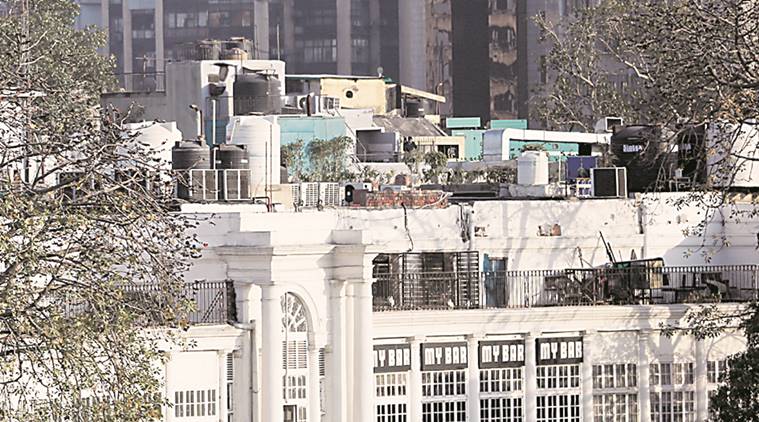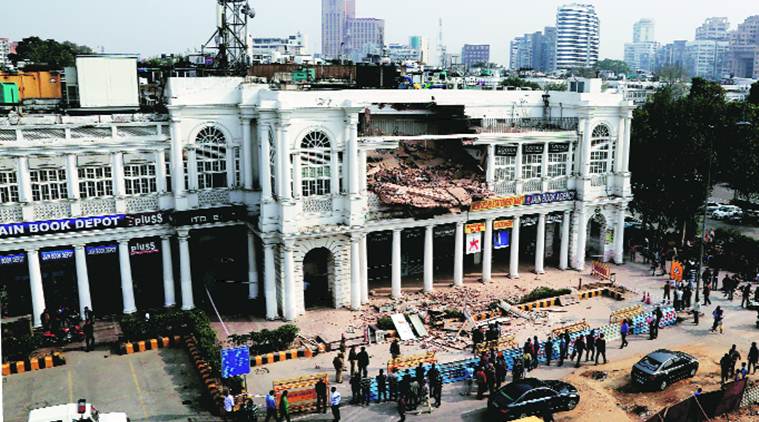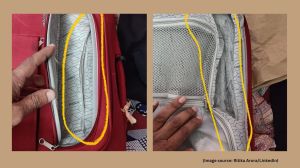Stay updated with the latest - Click here to follow us on Instagram
Two cave-ins at Delhi’s Connaught Place have exposed chinks and sent authorities into tizzy
The Indian Express speak to experts to understand the root of the problem.
 Heavy installations atop a Connaught Place building. Source: Tashi Tobgyal
Heavy installations atop a Connaught Place building. Source: Tashi Tobgyal
Two cave-ins at Connaught Place have exposed chinks in the decades-old commercial hub and sent authorities into a tizzy. But with the burden on its structures increasing with each passing year, finding a fix for CP is no easy task.
“CP was originally not designed to last this long,” says noted historian Sohail Hashmi, pointing out that the commercial centre was meant to have a life of about 60 years.


Against the backdrop of two cave-ins in a short span, he says the buildings were not meant to carry the weight they have been subjected to. Instead, the ground floor was supposed to serve as a shopping centre, and the first floor as homes.
“So what was a space for about four to five people (on the first floor) is now occupied by restaurants or offices with 250 people,” Hashmi says.
Read | After CP roof collapses, NDMC to conduct safety audit of Khan Market buildings too
The 84-year-old commercial hub — named after the first Duke of Connaught, Prince Arthur, and meant to mirror the Royal Crescent building complex at Bath, Somerset — was constructed with reinforced brickwork, like most buildings of the era.
Read | CP buckles under ‘excess load’: Roof of vacant shop collapses in Delhi’s Connaught Place
The Raisina Hills and the Rashtrapati Bhawan land belonged to the Maharaja of Jodhpur, while India Gate, Connaught Place and Jantar Mantar area belonged to the Maharaja of Jaipur.
According to Hashmi, despite the fact that the capital was shifted from Kolkata (then Calcutta) to New Delhi in 1912, it was officially inaugurated only in 1931 because permission had to be sought from multiple families to use this land to build the viceregal lodge, the Parliament and the commercial centre — Connaught Place.
Watch What Else Is making News
When renovation of the concentric circles that constitute CP began in 2008, it was perhaps already too late. AGK Menon of The Indian National Trust for Art and Cultural Heritage (INTACH) suggests that since much of CP is private property, responsibility of checking its structural integrity lies with the owner. “Ageing buildings have to be maintained. The nature of use of the Connaught Place buildings has been changed and the pressure has intensified, but restorations are only of the facade, not the structure.”
 The cave-in took place on February 2. Express photo
The cave-in took place on February 2. Express photo
While the New Delhi Municipal Council (NDMC) maintains it is “not their responsibility to check structural strength of shopping units because it is the onus of the owner”, PSN Rao, who heads the Department of Housing at the School of Architecture and Planning, suggests that testing the structural stability of a building — especially a heritage structure like CP — should ideally have been done by the NDMC, which is authorised to okay any new constructions or renovations in establishments in the complex.
“We should also have a body like the Mumbai Buildings Repairs & Reconstruction Board, set up to repair dangerous or ageing buildings, to prevent a disaster,” Rao says.
Explaining the composition of the structures, AK Jain, former commissioner of planning, DDA, says CP was built with reinforced brickwork (RBW) and is long past its shelf life. “CP is nearing 90 years of age and the RBW is badly in need of replacement with RCC (reinforced cement),” he says. However, conservation architects have raised concerns stating that changing the composition of the building would change its character.
Jain says numerous notes were sent to the Union Ministry of Urban Development, urging it to introduce building bylaws, which have a 30-year date of expiry.
“Buildings need a one-time approval from authorities before they are built. But we should introduce a system of building bylaws wherein buildings will be inspected and reissued approvals after 30 years. This will ensure structures are tended to and strengthened when they are found to be weakening,” he says.
Not just CP; even Palika Bazaar, located at its heart, is also crumbling. IIT-Delhi, which has been inspecting one of the Connaught Place cave-ins, was also roped in to inspect Palika Bazaar a few years ago, when chunks of concrete began falling off ceilings, shopkeepers at the nearly 50-year-old market say.
IIT-Delhi’s department of civil engineering sent experts to inspect Palika Bazaar in May 2013 on the NDMC’s request.
“When we inspected the buildings, we found severe corrosion of steel and spalling, and cracking of concrete in the market,” says an IIT professor on condition of anonymity.
“But after our initial visits, NDMC did not carry out the required procedures of sending a formal request and paying the required fees to IIT-Delhi, so we could not proceed with the work,” he says.
He adds that CP structures are not like ancient forts and palaces, which primarily used natural materials with virtually unlimited funds for construction. “So it is natural that deterioration has occurred in their condition over time. For such buildings of age, it is important to evolve a common strategy to prolong their life, instead of looking at them on a case-by-case basis which leaves rooms for errors,” he says.
IIT-Delhi has some advice
Following the cave-in at Block C in Connaught Place on February 2, the New Delhi Municipal Council (NDMC) roped in IIT-Delhi to carry out an inspection of the structure.
According to an expert from IIT’s department of civil engineering, the load on a structure and the structure’s capacity to carry the load keeps changing over time with deterioration and change in usage pattern. “The thing to understand about any collapse is that the capacity of the structure at that moment was lower than the load on it,” he said.
He added that the building that collapsed in CP was made of reinforced brick concrete — where a part of the concrete is replaced by bricks to reduce cost and load. In CP’s case, the load carrying capacity is 150kg/sq metre, though no heavy objects were found on the roof of the block which collapsed.
Also, any reinforced concrete structure deteriorates over time since it contains industrially produced materials such as cement and steel, which get affected by natural processes. While maintenance can prolong the life of such structures, they do not stop these processes. “There was evidence of construction work going on inside the building. A wall or a beam between the floor and the ceiling was removed because of which the first floor ceiling caved in,” the expert said.
He added that shops on the ground floor did not cave in because steel girders had been fixed in the ceilings during an earlier renovation.







